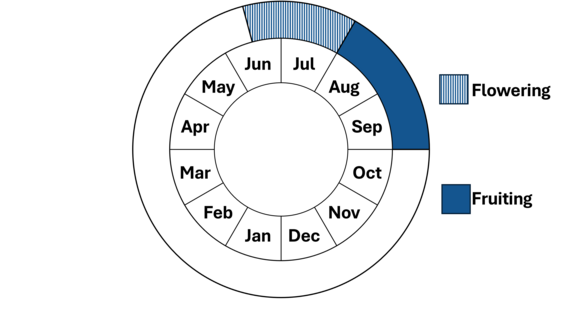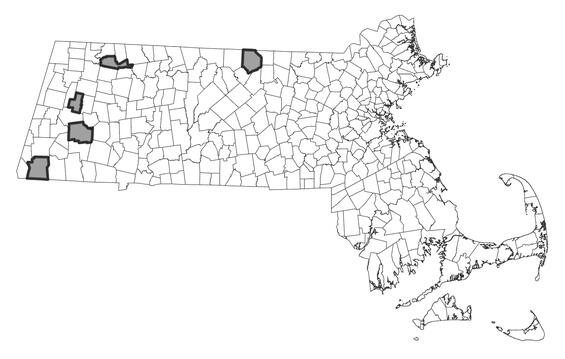- Scientific name: Moneses uniflora
- Species of Greatest Conservation Need (MA State Wildlife Action Plan)
- Special Concern (MA Endangered Species Act)
Description
One-flowered pyrola is a small, 3-10 cm (1.2-3.9 in) tall, evergreen, herbaceous perennial in the family Ericaceae (Heath family). As its name implies, it has one, waxy, creamy-white flower that blooms in June and July. It is borne on a stalk above one to four whorls of basal leaves. The flowers are fragrant and attract pollinating bumblebees. Plants grow from horizontal roots in a clonal group in cool, mesic shade in pine woodlands or bogs, in litter or on mossy banks.
One-flowered pyrola is mycoheterotrophic (dependent or parasitic on host fungi for nutrients) during seed germination and seedling development (Johnson 2014). Seedlings remain underground for several years before forming above-ground basal leaves and then become autotrophic (nutrients synthesized using energy from photosynthesis; Johnson et al. 2015).
One-flowered pyrola is fairly easy to identify. The single, nodding, rotate (radially symmetrical) flower is 1.5-2.5 cm (0.75-1 in) across. It has five petals that are 8-12 x 4-8 mm (0.38 x 0.25 in) with minute teeth on the margins, a stigma with five erect marginal lobes, and ten anthers. Leaves are sub-orbicular, 1-2 cm (0.5-1 in), glossy green on the upper-side and dull green on the underside with slightly dentate-crenate (rounded teeth) margins. Fruit is a sub-orbicular capsule approximately 4-8 x 5-9 mm (0.25 x 0.25 in) which is borne upright and opens from the top down with approximately 1000 dust (minute) seeds.
Moneses (meaning “single delight”) is a monotypic genus (having one species in the genus). In Massachusetts, the species that are most similar are small herbaceous or woody species also in the Ericaceae. Shinleaf (Pyrola spp.), one-sided pyrola (Orthilia secunda), and pipsissewa (Chimaphila spp.) all have more than one flower in an inflorescence. Wintergreen (Gaultheria procumbens) has one to several urn-shaped flowers, compared to one-flowered pyrola which has one rotate flower. One-flowered pyrola is much smaller than other similar members of the Ericaceae and may be overlooked in Massachusetts.

One-flowered Pyrola (Moneses uniflora)
Life cycle and behavior
This is a perennial species.

Population status
One-flowered pyrola, listed under the Massachusetts Endangered Species Act as special concern, is thought to be in decline. All listed species are protected from killing, collecting, possessing, or sale and from activities that would destroy habitat and thus directly or indirectly cause mortality or disrupt critical behaviors. When found, populations are small and may represent one genet (clonal group) rather than genetically different individuals. It has been reported from 13 locations in Massachusetts in Berkshire, Franklin, Hampden, Hampshire, Worcester, Middlesex, Essex, and Plymouth counties, though only six have been observed since 1990.

Distribution in Massachusetts. 1999-2024. Based on records in the Natural Heritage Database.
Distribution and abundance
One-flowered pyrola is a circumboreal species with a range in North America from New England south to Pennsylvania and west to California and Arizona (in mountainous areas) and includes all of Canada. Although ranked as a globally secure species, it is thought to be in decline globally. It is critically imperiled in Connecticut, Rhode Island, and Ohio.
Habitat
One-flowered pyrola and its mycorrhizal hosts are usually found in deep pine litter or mosses and decaying woodland humus, in cool shady sites with an open understory which allows intermittent sunlight. One site was reported on a mossy bank atop a limestone cobble. Other associated woody species in the white pine (Pinus strobus) stands include black cherry (Prunus serotina), sugar maple (Acer saccharum), red maple (Acer rubrum), and highbush blueberry (Vaccinium corymbosum), and the woody invasive Japanese barberry (Berberis thunbergii). Herbaceous associates often include elliptic shinleaf (Pyrola elliptica), Canada mayflower (Maianthemum canadense), starflower (Lysimachia borealis), and checkered rattlesnake-plantain (Goodyera tesselata).
One-flowered pyrola is occasionally found in red pine (Pinus resinosa) stands which were planted as reforestation projects of old fields and logging sites, frequently near reservoirs. These sites include a similar array of associated species as in white pine stands.
Healthy habitats are vital for supporting native wildlife and plants. Explore habitats and learn about conservation and restoration in Massachusetts.
Threats
This plant species may be in decline partially because of limitations of seed dispersal to appropriate habitat with mycorrhizal associates. The seed usually grows only near parent plants, rather than germinating in more distant locations. Soil nutrients, moisture, pH, and canopy are important factors to both one-flowered pyrola and its mycorrhizal associates. Land use that disturbs soils and opens the tree canopy can be disruptive of these processes by increasing light and changing soil moisture regime. In several of the known populations in Massachusetts, Japanese barberry is a threat to the fairly open understory habitat.
Conservation
These plants may be overlooked because of the diminutive size of the plants and the small populations. Searches should be done in white or red pine woodlands during late June or July during flowering season when it is easiest to identify, although the plants can also be found during vegetative and fruiting stages. To prevent destruction of potential habitat in white pine stands and red pine plantings, these woodlands should be searched before logging and wide buffer zones created around populations if any are found. Native white pine forest renewal processes should be encouraged before red pine plantings are removed during forest improvement management. Invasive woody species, especially Japanese barberry, should be controlled; however, caution should be used to prevent extensive soil disturbance near populations. All active management of state-listed plant populations (including invasive species removal) is subject to review under the Massachusetts Endangered Species Act and should be planned in close consultation with the MassWildlife’s Natural Heritage & Endangered Species Program.
References
Johnson, V.A.. 2014. Recruitment ecology and fungal interactions in mycoheterotrophic Ericaceae. Dissertation. Stockholm: Department of Ecology, Environment and Plant Science, Stockholm University.
Johnson, V.A., A. Mikusinska, E. Ekblad, and O. Eriksson. 2015. Partial mycoheterotrophy in Pyroleae: nitrogen and carbon stable isotope signatures during development from seedling to adult. Oecologia (2015) 177: 203-211.
Contact
| Date published: | May 8, 2025 |
|---|